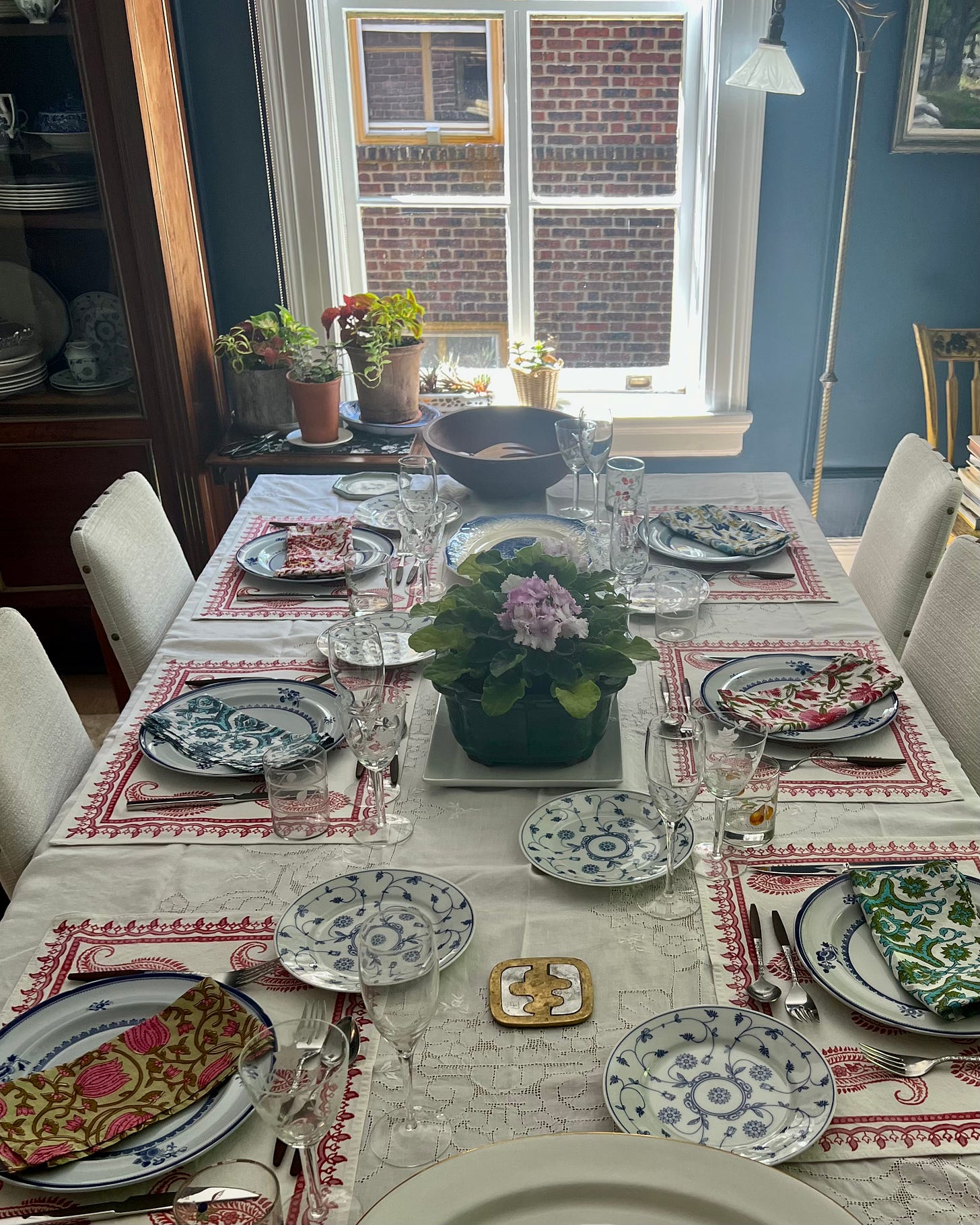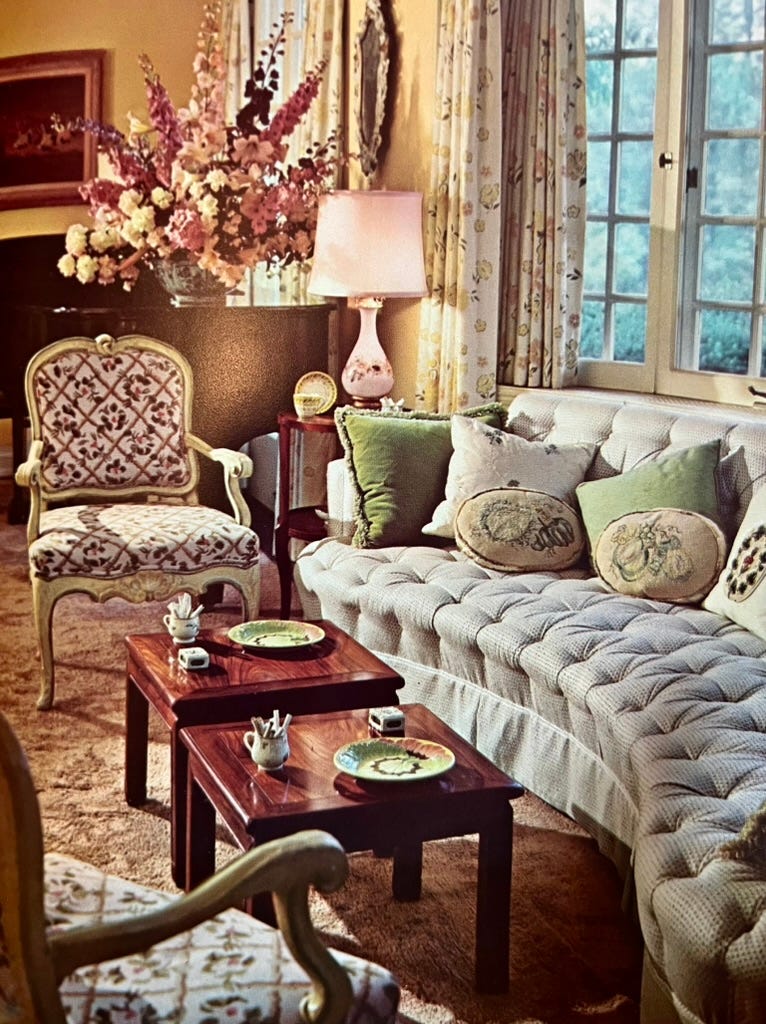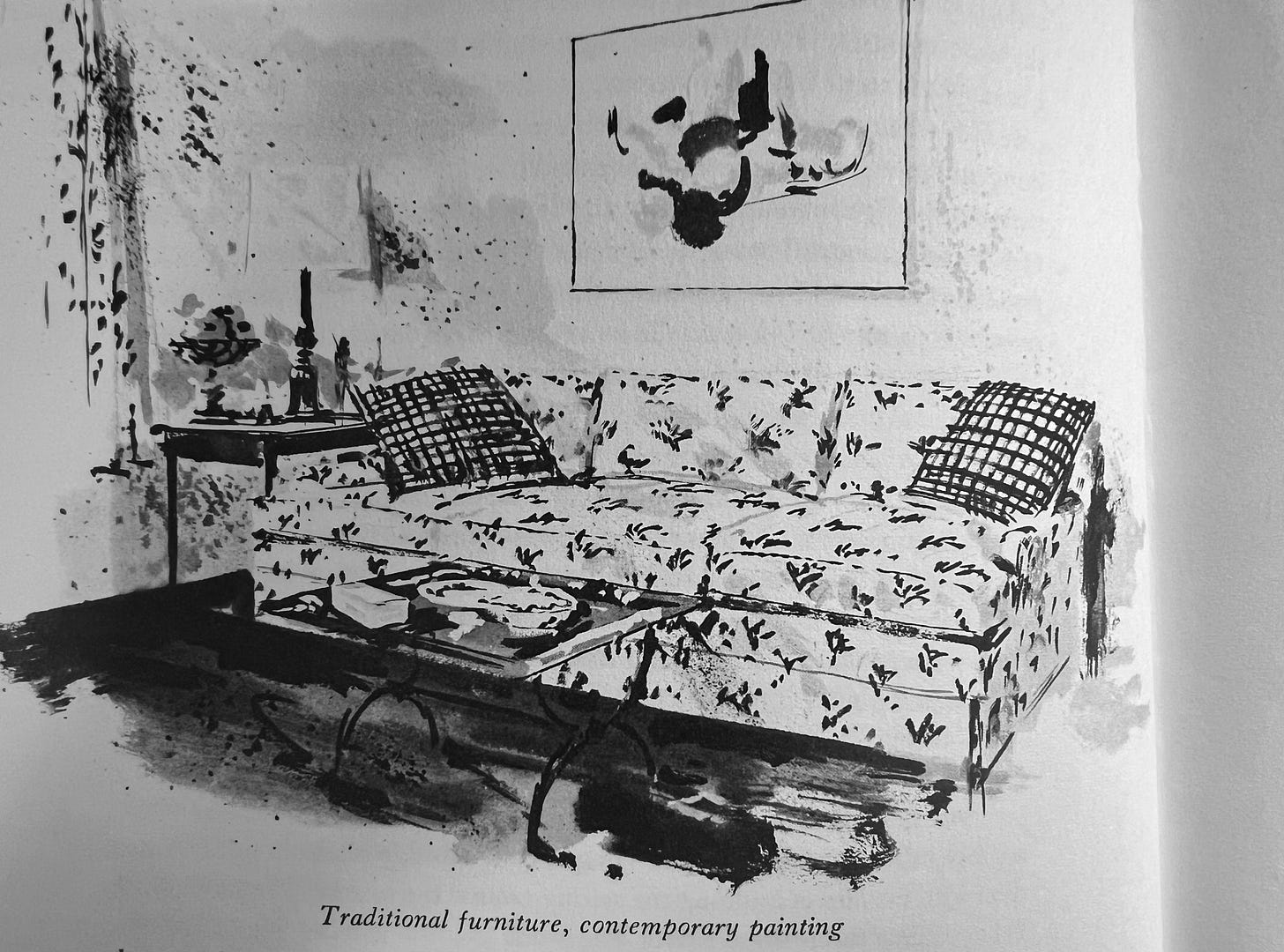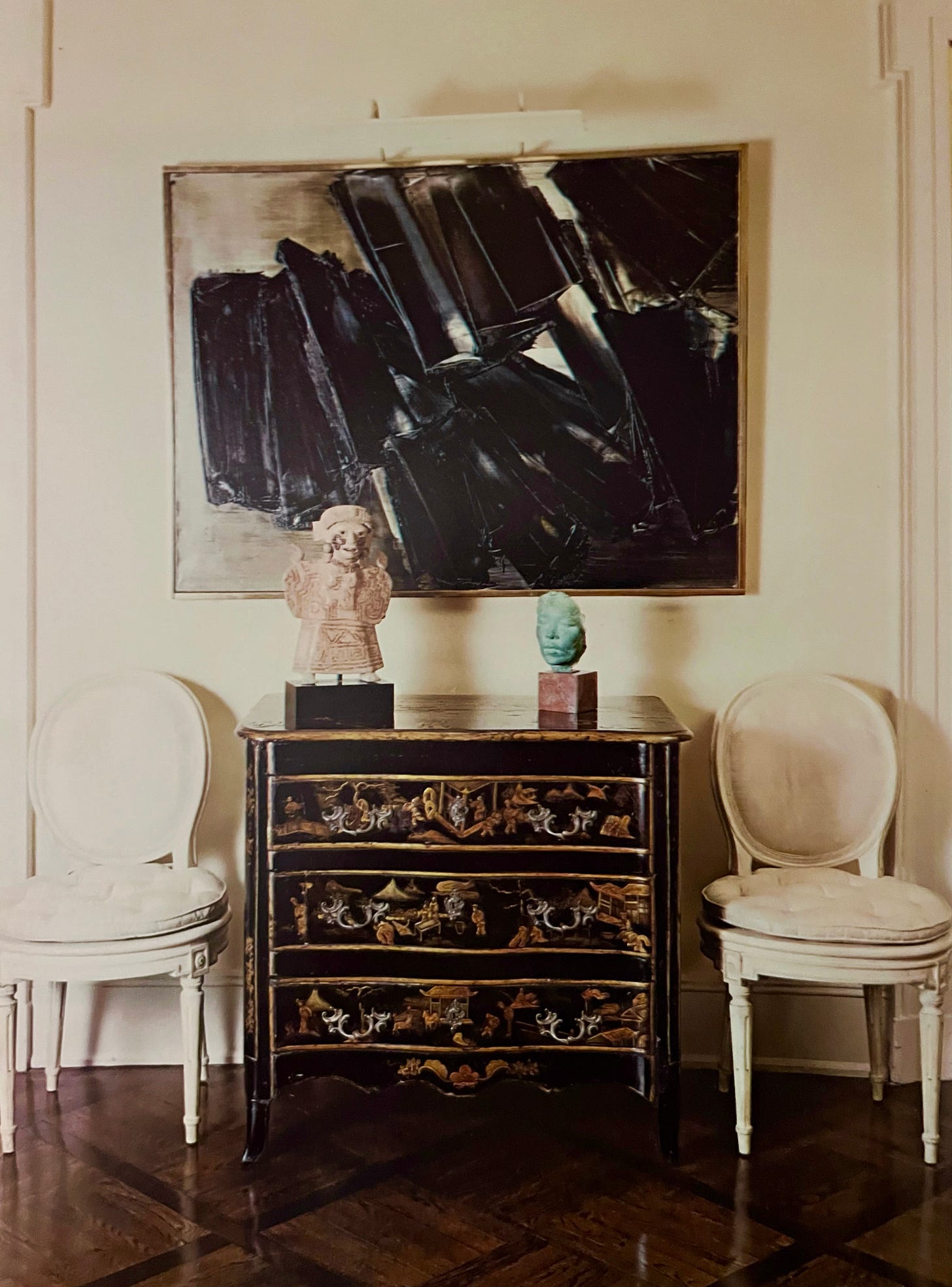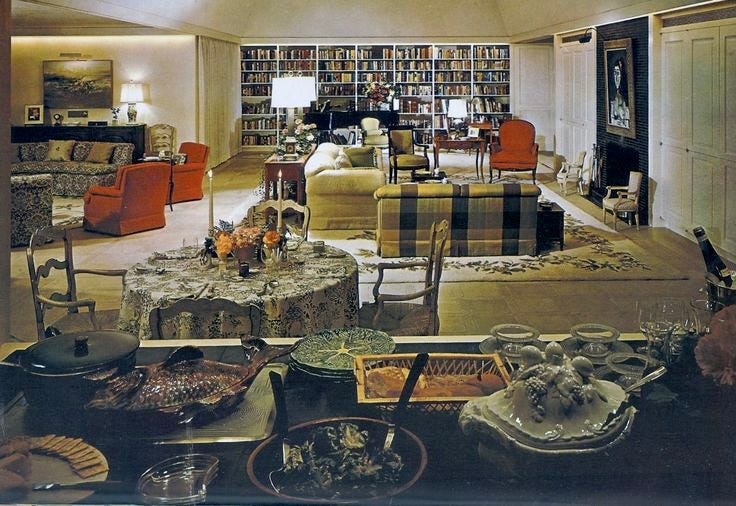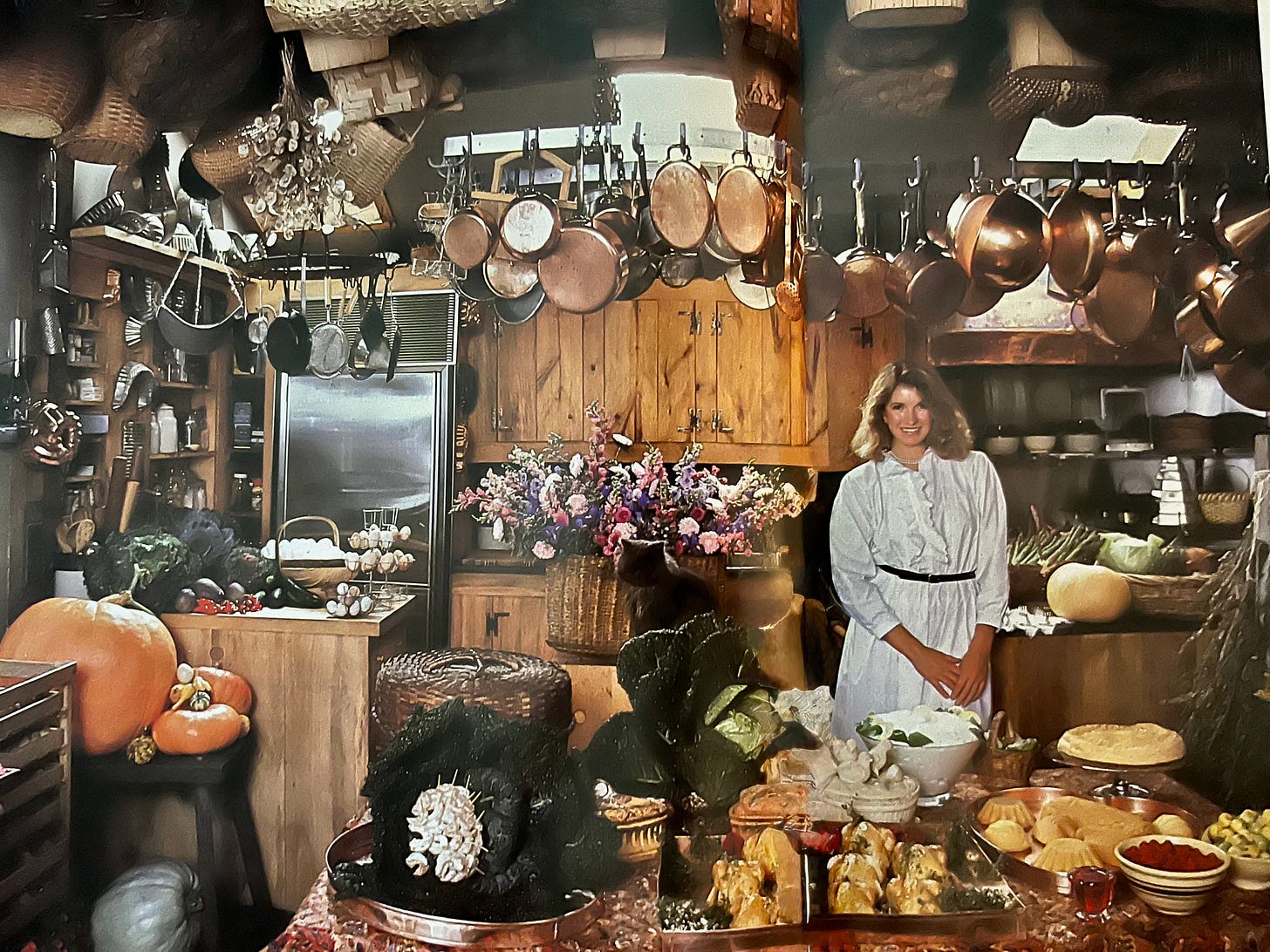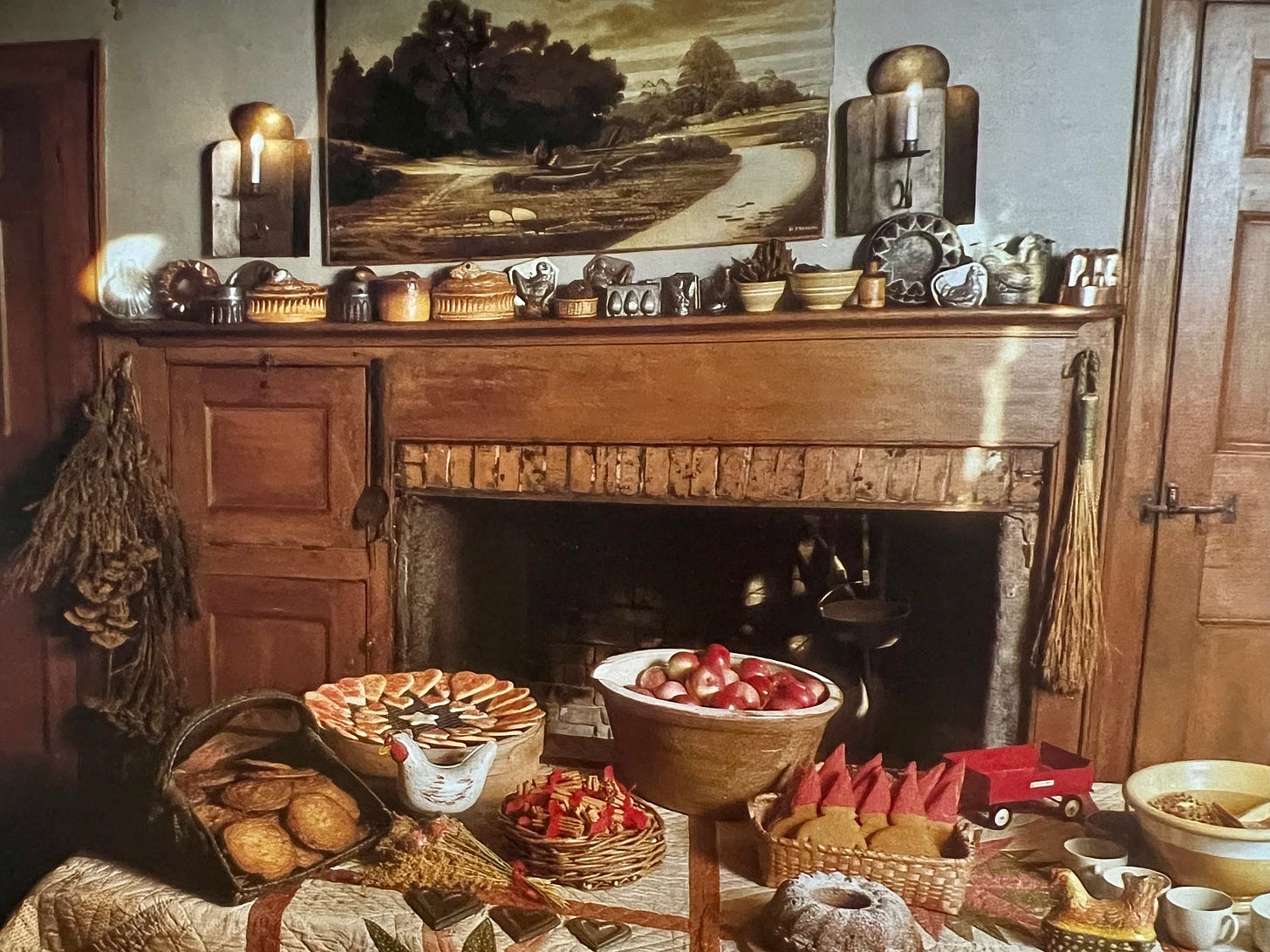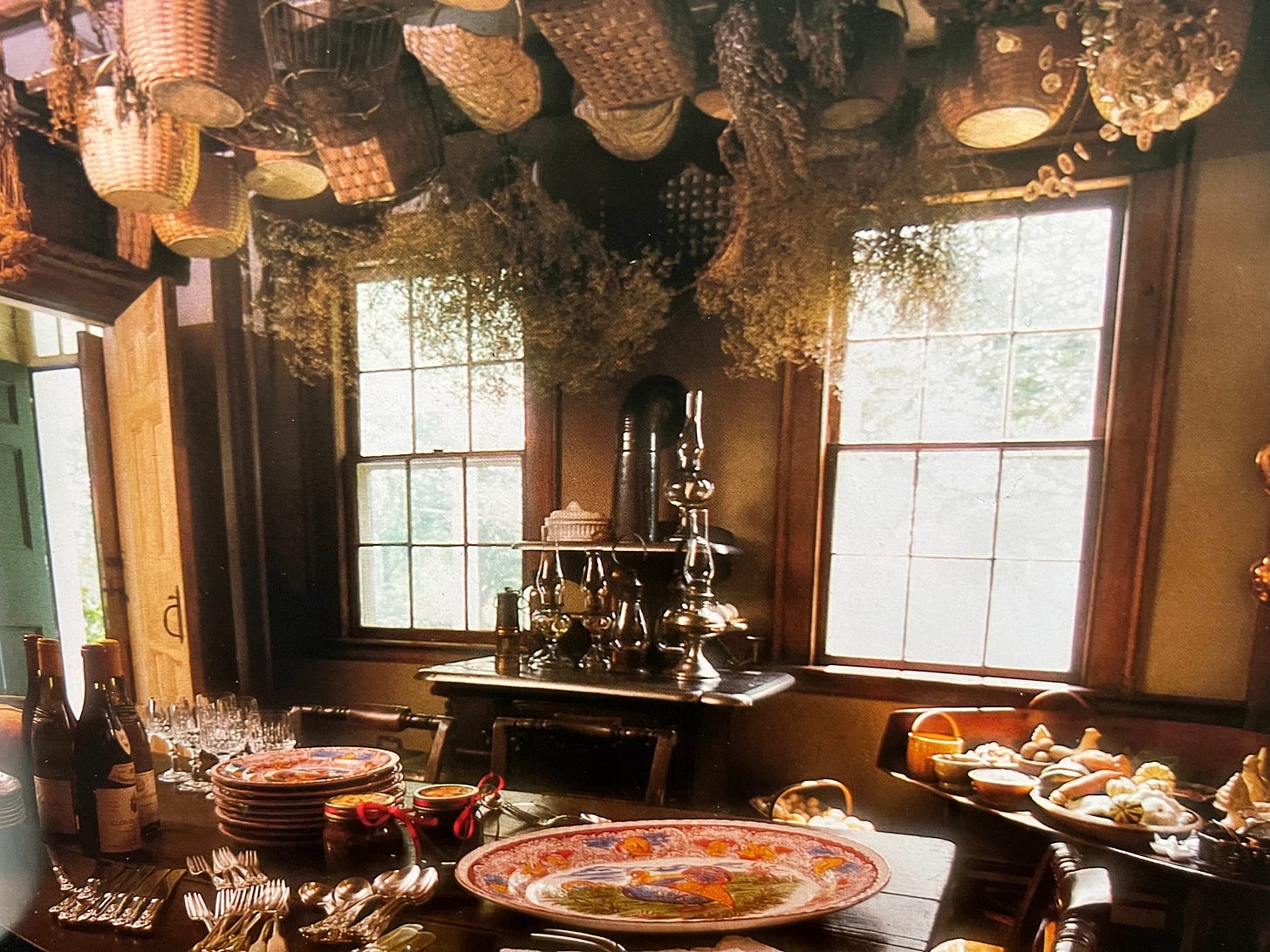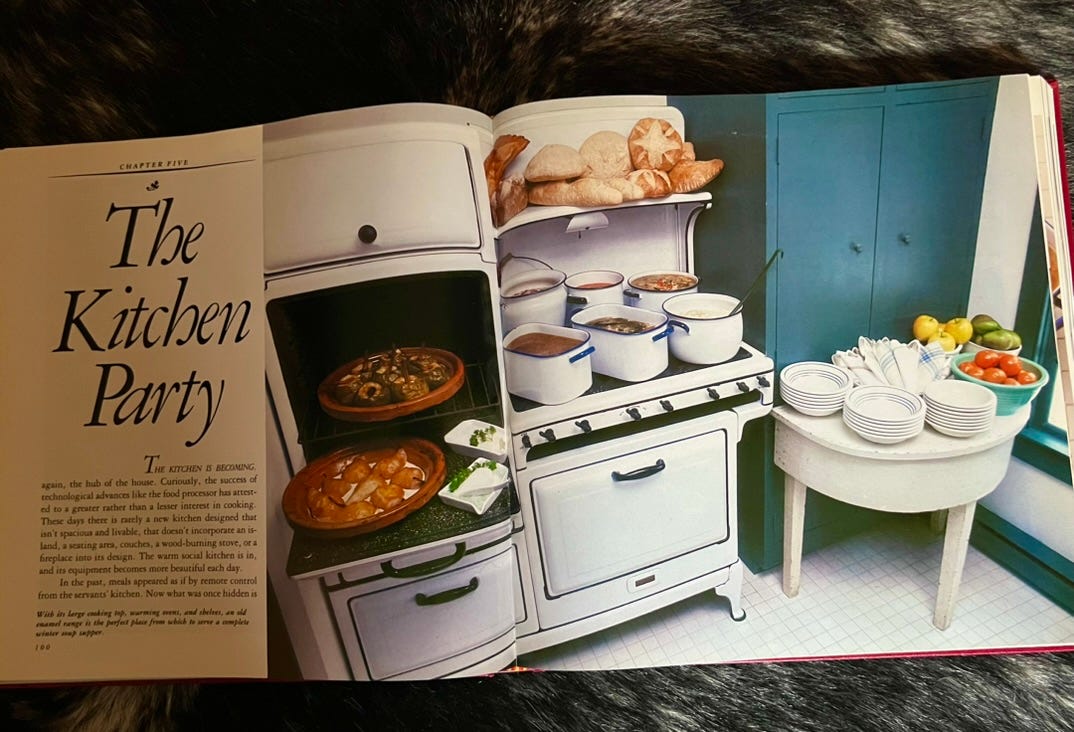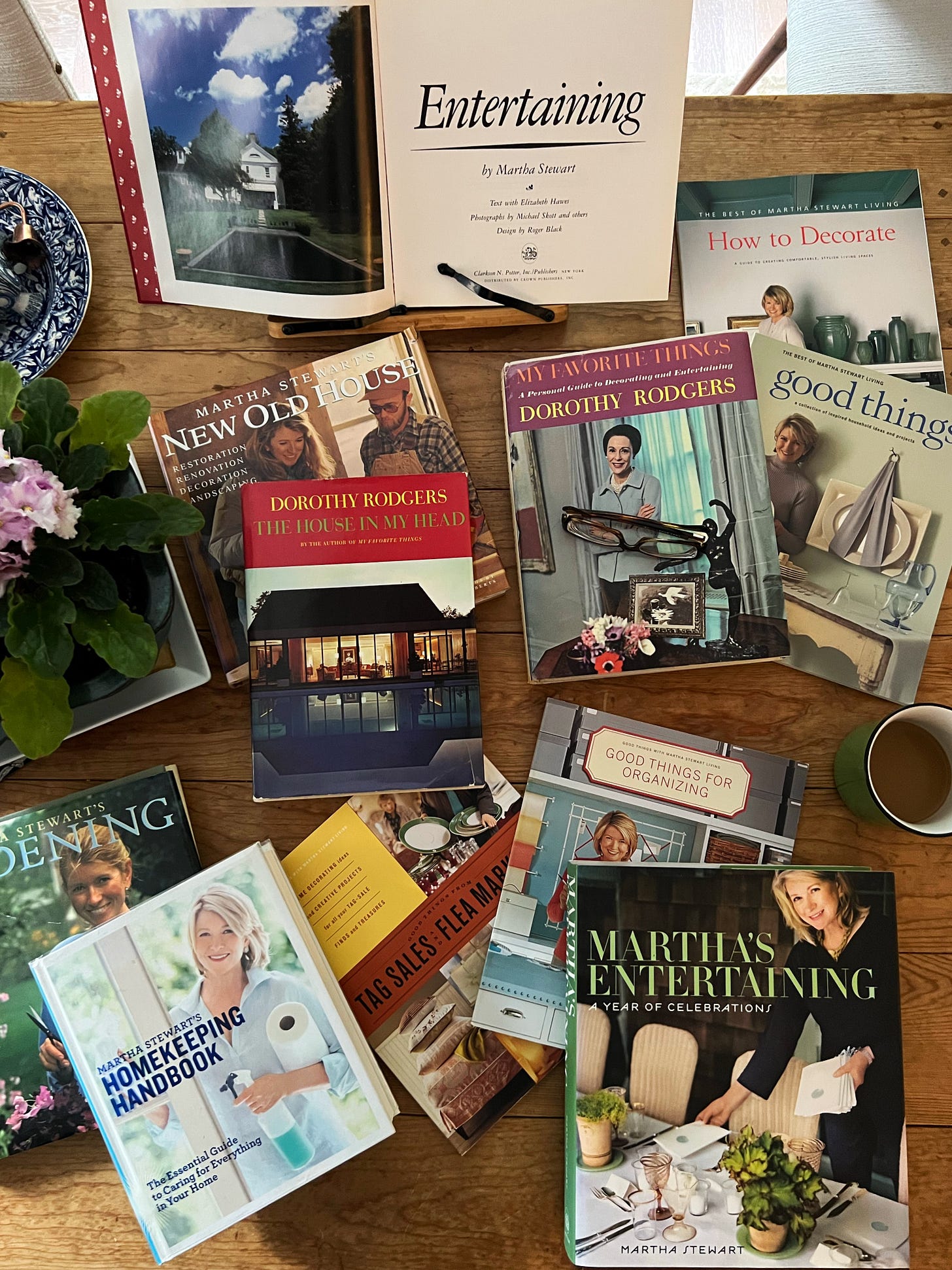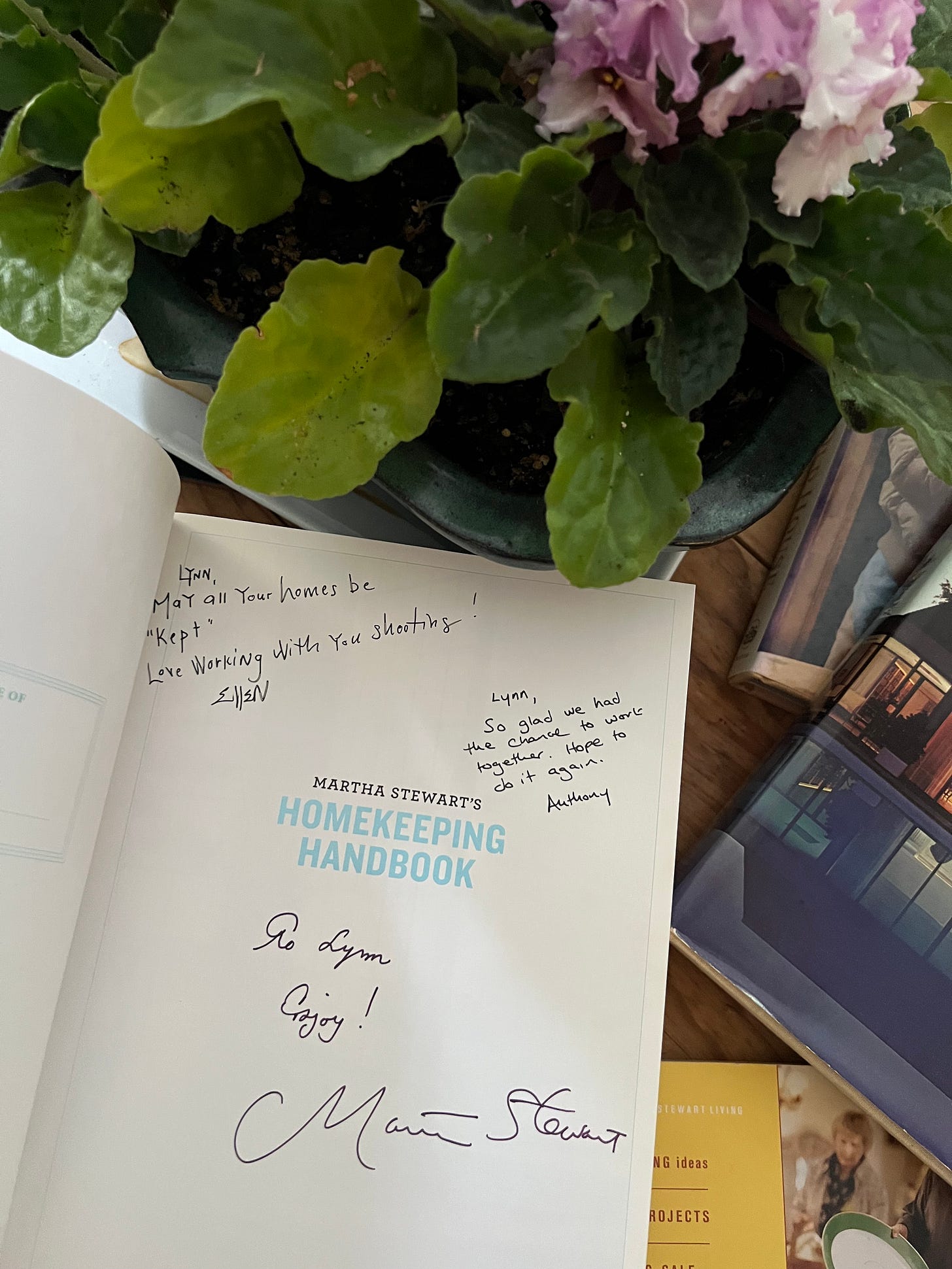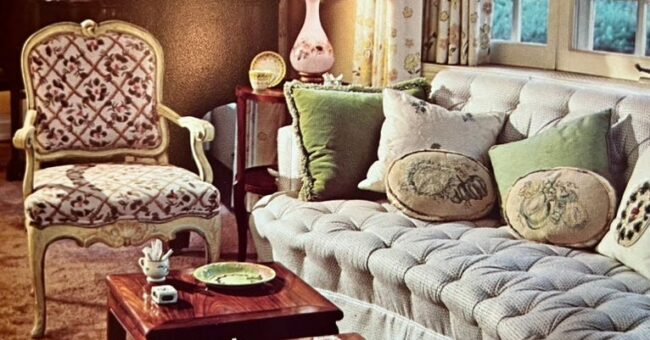
Just this past weekend, I was called a “Martha” again. Of course I knew whom I was being compared to. Although there have been “Marthas” (of one sort or another) since biblical times, when it comes to anything related to homemaking today, there is only one “Martha”: the ubiquitous Martha Stewart.
What led to the use of the Martha moniker being applied to me? I had put some effort into a spring luncheon for friends and, apparently, it showed. My menu of roast organic chicken and fennel, green bean and chicory salad was capped with a glazed, lemon bundt cake baked from scratch. I served it on a table laid with Indian block print linens found in California at the Rose Bowl Flea Market and set with a vintage mix of blue and white dishware (mostly from Etsy) and wood-handled, midcentury cutlery I had inherited from my parents. Putting all that together was fun for me, and if that makes me a “Martha,” ok, I’ll own it. I have nine of her books including my first edition of her breakout volume, Entertaining, purchased shortly after its publication in 1982. Martha Stewart’s recipe for French Onion Soup (page 114) in Entertaining remains my go-to recipe for that savory concoction.
This time, I have every reason to believe that the reference to Martha Stewart was meant as a compliment, but, honestly, one can never be quite certain. Sometimes, being called a “Martha” is a subtle sneer insinuating that your desire to devote time to living graciously is at best a sign of neurotic perfectionism and, at worst, an indication that the goal itself is archaic and you have nothing better to do.
However, here’s the irony. It’s actually the veiled sneer that is outmoded. Martha Stewart has found legions of new fans, Gen Z’ers who admire her grit, can-do spirit and multi-hyphenate life. Calling her “fierce” and finding her ideas an “inspiration,” they are snapping up secondhand copies of the out-of-print Entertaining sparking Ebay bidding wars that easily jack up the price for this classic (hardcover and in good condition) to a hundred dollars or more.1 The tome has become so sought after that its publisher, Clarkson Potter, plans to reissue it after more than forty years —an extraordinary thing for a lifestyle book.
For those of you who admire Martha Stewart as the first female self-made billionaire and as a seminal cultural icon, let me introduce you to another bad-ass female home maven, Dorothy Rodgers. Many have dubbed Martha Stewart the “Original Influencer” especially since the recent Netflix documentary about her, but if you read Dorothy’s lifestyle books written almost two decades before Entertaining, you can’t help but wonder if she influenced Martha. The similarities between the two are uncanny in many respects.
While Dorothy Rodgers had a much more privileged upbringing than Martha, both women turned traditional feminine roles of homemaker and hostess into formidable business enterprises. Dorothy founded a venture in 1935 dubbed Repairs, Inc. that offered expert repair services for all sorts of broken household objects. She had carpets rewoven, furniture refinished, porcelain re-glued and drapery mended all by a stable of master craftspeople who could repair almost anything, returning the newly, good-as-new items in a maroon box tied in white cotton ribbon. (Someone, anyone, please bring this gig back!) Repairs, Inc. organically led to her becoming a decorator. In addition, Dorothy was an inventor. She patented one product in 1945, the Jonny-Mop (used for cleaning toilets), that was purchased by Johnson & Johnson thereby yielding handsome royalties she gave to her two daughters. There were other inventions like a reusable sewing pattern for dresses bought by McCalls in 1958 and the Turn and Learn framework for children’s books that was sold to the Ideal Toy Company in 1972. But it is her role as an author of lifestyle books that seems like an early blueprint for the future Martha Stewart’s career.
Martha Stewart once said that “All the things I love is what my business is all about.” 2 Coincidentally (or not, I don’t know if Martha ever read Dorothy), in 1964, Dorothy Rodgers published her first book called My Favorite Things, A Personal Guide to Decorating and Entertaining, which spent 4 weeks on the New York Times best-sellers list. The title is drawn from a song written by her much more famous husband, Richard Rodgers, for the musical The Sound of Music. In it, Dorothy covers decorating, renovations, collections, crafting, flower arranging, cooking and entertaining, all the topics devotees will recognize as having been later featured in Martha Stewart’s magazine, Living. Dorothy thought these were all “good things” long before Martha ever coined the phrase.
Granted some of the content in My Favorite Things is dated—the husband/wife advice and tips for managing household staff are truly antiquated, written as they were by a wealthy woman more than sixty years ago— but most of the advice remains smart and valid. Certainly if you read My Favorite Things, you will come away with knowing the mechanics of how to throw a dinner party, penned by Dorothy while Martha was just starting out as a fashion model. Alright, it’s true: we no longer cook Dorothy mainstays like tomato aspic and red caviar soup much these days, but it might be fun to try.
Among the other pearls in My Favorite Things, Dorothy forecasts the current vogue for ‘slow decorating.’ “In an over-all sense, decorating cannot, should not, be hurried. It may be months, even years before you know what you really want to do with a room,” Dorothy writes.3 She goes on to suggest mixing historical periods in your rooms pointing out that combining contemporary art with antique furniture can freshen everything up. When it comes to kitchens and entertaining, Dorothy was a prescient admirer of the big pantries so popular today and she loved commercial-grade appliances. My favorite gem in the volume? “Taste is made, not born. There is no mystique about it; it is not an occult science and it doesn’t spring full-blown like Venus. It is a matter of educating your eye, and it is really no different from developing any other sense to its full power.”4 So Dorothy was fervent about her perspective on taste and “educating the eye”— and drove this notion home for the reader.
The imagery in My Favorite Things will inspire grand millennials everywhere. Dorothy, like Martha, seems to have recognized the power of a good picture. In addition to some classic color photos, the book is peppered with illustrations by Jeremiah Goodman who has since become the foremost interiors renderer of our time.
Dorothy’s next book, written in 1967, The House in My Head has a cult following among design nerds in the know. Christopher Maya, one of Architectural Digest’s AD100 designers, says he would order it “for everyone if I could.”5 Experts like Christopher consider it required reading for anyone embarking on a substantial residential building project. In the book, Dorothy recounts step by step how she designed, built and decorated her dream house in Fairfield, Connecticut, including the landscaping. Color photographs were mostly shot by the acclaimed photographer Ezra Stoller and also appeared in House Beautiful. In Dorothy’s later memoir, A Personal Story, she writes that building her dream house was one of “…the most rewarding and satisfying things I’ve done…”6 It wouldn’t surprise me if Martha felt the same about her renovations on her famed farmhouse, Turkey Hill in nearby Westport, especially since it helped establish her empire. I devoured The House in My Head just after I rebuilt our fire-destroyed Victorian and I wish I had come across it earlier. Anyone who is tackling a renovation will likely find something in there they can relate to.
And let’s not forget, while Dorothy was doing all this, she raised two children, managed the substantial family finances (according to her daughter Mary, essential, because her songwriter father, “would sign anything and would end up giving away the farm”)7, served on several philanthropic boards, and gave countless parties. Fierce, inspirational and multi-hyphenated, I think Gen Z’ers would love her too if they got to know her.
The vigor and exactitude with which both Dorothy and Martha tackled their respective endeavors is extraordinary. Both have expressed joy in regularly learning something new8. Martha’s expertise and high standards are widely recognized. Dorothy’s are comparable. She studied furniture design with the acclaimed midcentury designer Paul Frankl (you can see his “skyscraper’ furniture at the Met).9 To learn to cook, she took lessons from the first female graduate of Le Cordon Bleu, Dione Lucas10. Hoping to improve her embroidery skills she enrolled in the Royal School of Needlework in London. When she decided to teach herself to sew on a machine, she took the free lessons offered by Singer, eventually becoming expert enough to design and sew her own clothing and her husband’s sport shirts (in raw silk, naturally). Eventually, she began to send her self-designed suits to be sewn up by a dressmaker. I guess something had to give.11
Both woman were also the target of similar criticisms: too perfect, too controlling, too cold, even referred to occasionally in this way by their children. When it comes to Martha, you have likely heard all that before, but Dorothy suffered too. Stephen Sondheim once called her “one of the real monsters of the world.”12 Ouch! Of course, reports will vary and the validity of these assessments is beyond the scope of this post.
I think more fascinating is the origin question. Did Dorothy Rodgers provide a road map of sorts for Martha Stewart ? I can’t prove it but it certainly seems possible. Indeed, although she doesn’t mention Dorothy Rodgers specifically, Sarah A. Leavitt, a cultural historian and author of the book From Catherine Beecher to Martha Stewart, A Cultural History of Domestic Advice, writes that Martha and her employees regularly mined past works for inspiration and to learn about historical decorating. 13 I would give my eye teeth to interview Martha Stewart to ask her directly.
Whatever the answer, Dorothy Rodger’s packaging of her personal life as an aspirational aesthetic some twenty years before Martha carefully marketed hers this way, blazed a trail for all of the lifestyle influencers to come after her. Not only are her books filled with fun and interesting advice but, when viewed through the lens of women’s history, she was unquestionably an early pioneer for what is now a huge business. Nothing beats a determined woman who “gets it done.”
Bon voyage,
Lynn
Photography
First image is my table set for lunch. The following photos are snaps and scans from the books referenced, so pardon the blur, etc.
My Favorite Things
Dorothy’s first country house. The needlepoint on the sofa’s round pillows was done by her.
Back then husbands and wives slept separately. Here is Dorothy’s bedroom.
Very Marie Kondo of Dorothy to snatch storage under the back stairs of her New York apartment to store her pots. (Goodness, where are these NYC apartments large enough to have back staircases?!).
Love her visionary advice in 1964 to hang modern art over traditional furniture.
The House in My Head
Dorothy was lucky enough to be able to hang a Picasso over the fireplace in the house in her head. She also designed a massive living and dining space, a precursor to the later “great” rooms, because she sought more informal living.
Designer Susan Zises Green later redecorated this room, removing some of the bookcases, and her version was also published by House Beautiful.
Entertaining
Martha at one of her luncheons at Turkey Hill.
Martha’s kitchen at Turkey Hill.
Back in the early 1990s, I actually followed all the steps for this party and threw it with some friends.
Further Reading
Do you want to know why these books by Martha Stewart survived my various downsizing? Let me know in the comments.
Post Scriptum
-
Went to Connecticut this weekend and saw some divine Turner paintings at the Yale Center for British Art. Check it out before it closes on July 27.
-
I am buying all the wild garlic I can find at my local farmer’s market to try this chicken, since I never get much to eat at my own parties.
-
One of my boys got engaged! Calling my friend Jolain for help on all the clothes I need.
The World According to Martha, by Bill Adler via https://www.brainyquote.com/quotes/martha_stewart_173344#google_vignette
My Favorite Things, by Dorothy Rodgers, page 25.
My Favorite Things, page 12.
A Personal Book, by Dorothy Rodgers, p. 172.
My Favorite Things, page xv and in “Martha”, the Netflix documentary.
A Personal Book, p.161
